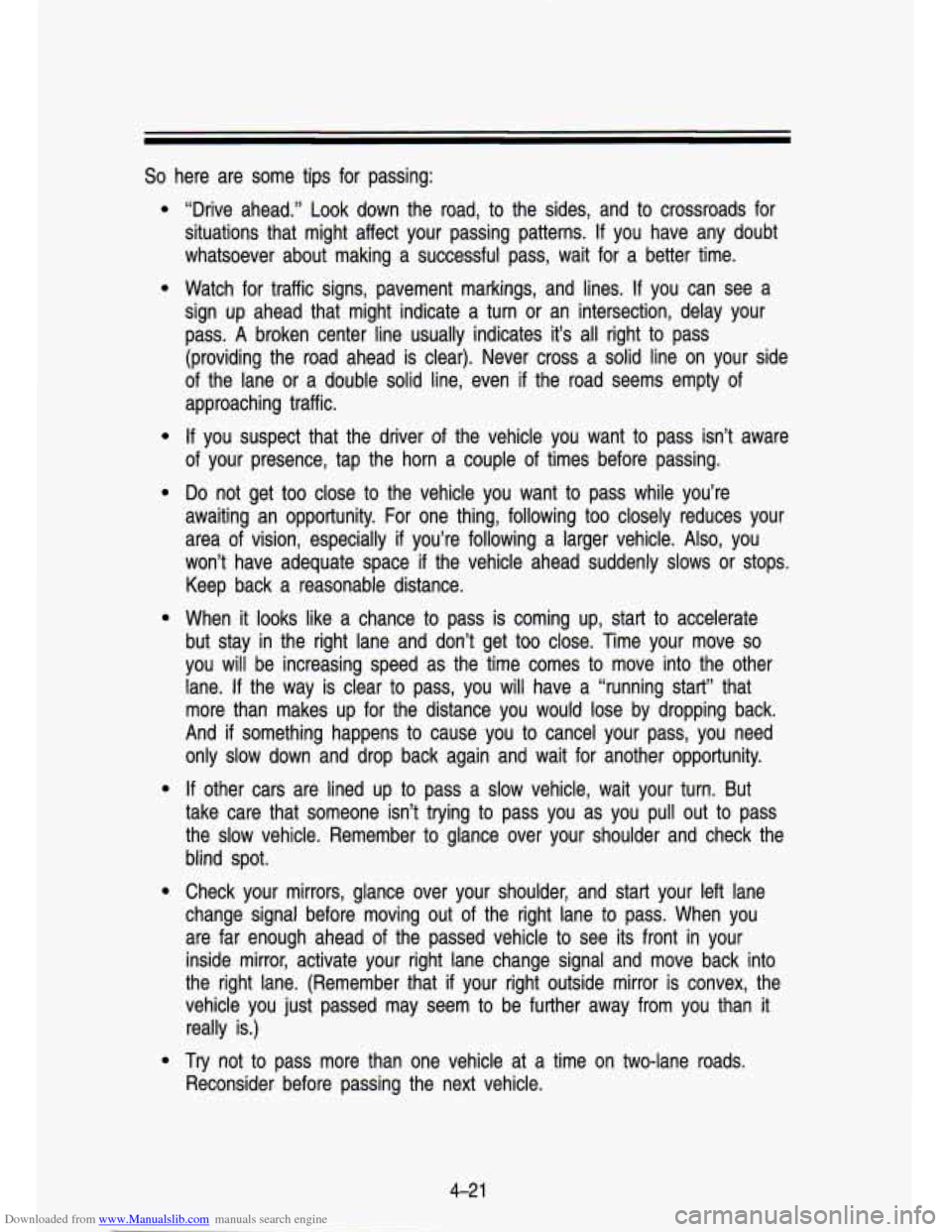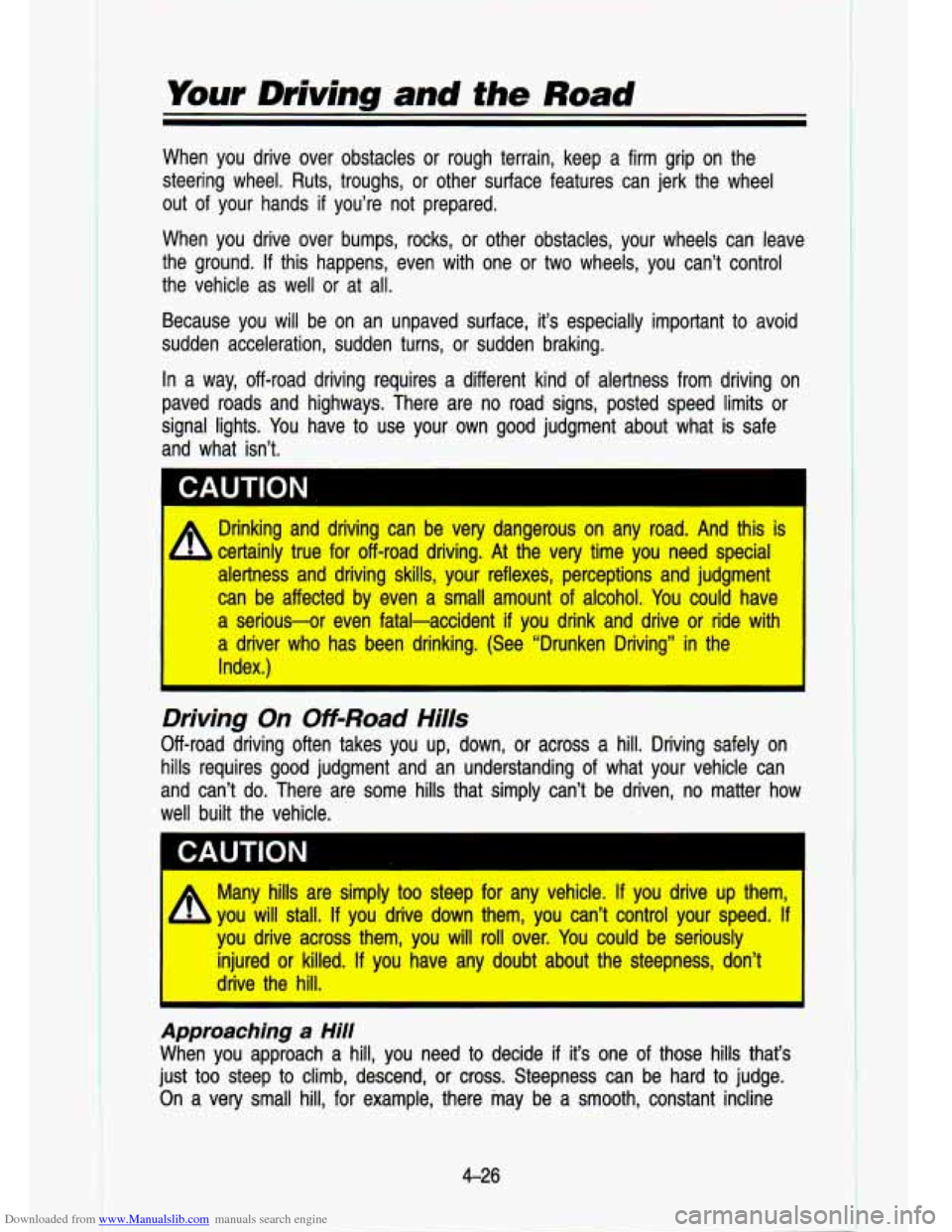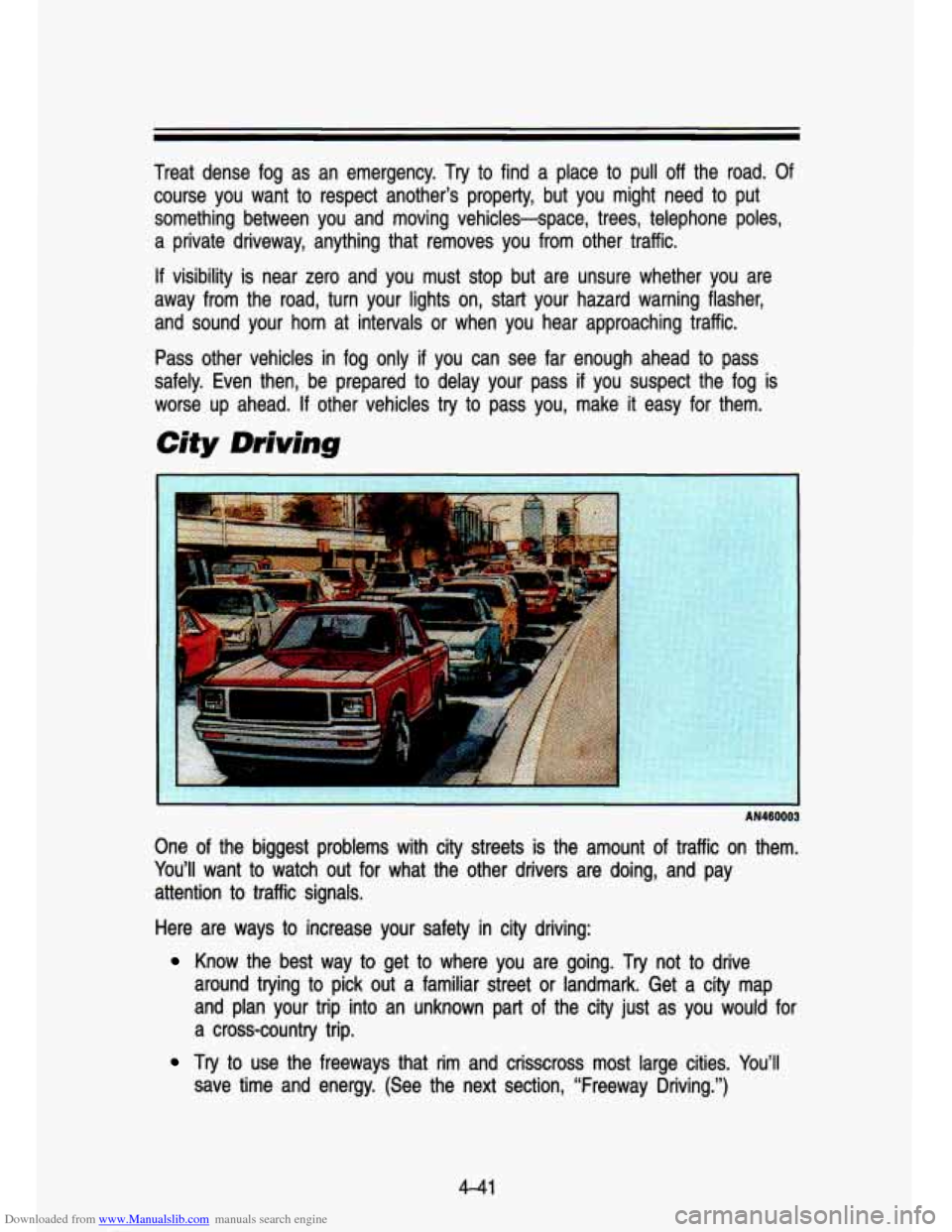1993 CHEVROLET S10 turn signal
[x] Cancel search: turn signalPage 161 of 356

Downloaded from www.Manualslib.com manuals search engine Some traffic lights also use red arrows to signify that you must stop before
turning on red.
Many city roads and expressways, and even bridges, use reversib\
le-lane
traffic control during rush hours.
A red X light above a lane means no driving
in that lane at that time. A green arrow means you may drive in that lane.
Look for the signs posted to warn drivers what hours and days these
systems are in effect.
AM40201 5
Pavement Markings
AM40201 6
Pavement markings add to traffic signs and signals. They give information to
drivers without taking attention from the roadway.
A solid yellow line on your
side of the road or lane means “don’t cross.”
Your - Own Signals
Drivers signal to others, too. It’s not only more polite, it’s safer to let other
drivers know what you are doing. And in some places the law requires driver
signals.
4-7
Page 162 of 356

Downloaded from www.Manualslib.com manuals search engine c. -. .. .
Your Driving and the Road
Turn and lane change signals: Always signal when you plan to \
turn or
change lanes.
If necessary, you can use hand signals out the window: Left arm \
straight out
for a left turn, down for slow or about-to-stop, and up for a right turn.
Slowing down:
If time allows, tap the brake pedal once or twice in advance
of slowing or stopping. This warns the driver behind you.
Disabled: Your four-way flashers signal that your vehicle is disabled or is a
hazard. See “Hazard Warning Flasher’’ in the Index.
Traffic Officer
The traffic police officer is also a source of important information. The officer’s
signals govern, no matter what the traffic lights or other sig\
ns say.
The next part discusses some of the road conditions you may encounter.
Defensive Driving
The best advice anyone can give about driving is: Drive defens\
ively.
Please
start with a very important safety device in your vehicle: Buckle up.
(See “Safety Belts” in the Index.)
Defensive driving really means “be ready for anything.” On\
city streets, rural
roads, or freeways, it means “always expect the unexpected.”
Assume that pedestrians or other drivers are going to be careless and make
mistakes. Anticipate what they might
do. Be ready for their mistakes.
Expect children to dash out from behind parked cars, often followed by other
children. Expect occupants in parked cars to open doors into traffic. Watch for
movement in parked cars-someone may be about to open a door.
Expect other drivers to run stop signs .when you are on a through street. Be
ready to brake
if necessary as you go through intersections. You may not
have to use the brake, but if you
do, you will be ready.
If you’re driving through a shopping center parking lot where there are
well-marked lanes, directional arrows, and designated parking are\
as, expect
some drivers to ignore all these markings and dash straight toward one part
of the lot.
Pedestrians can be careless. Watch for them. In general, you m\
ust give way
to pedestrians even
if you know you have the right of way.
Rear-end collisions are about the most preventable of accidents. Yet they are
common. Allow enough following distance. It’s the best defens\
ive driving
4-8
Page 175 of 356

Downloaded from www.Manualslib.com manuals search engine So here are some tips for passing:
e
e
e
e
e
e
e
“Drive ahead.” Look down the road, to the sides, and to \
crossroads for
situations that might affect your passing patterns.
If you have any doubt
whatsoever about making a successful pass, wait for a better t\
ime.
Watch for traffic signs, pavement markings, and lines.
If you can see a
sign up ahead that might indicate a turn or an intersection, \
delay your pass.
A broken center line usually .indicates it’s all right to pass
(providing the road ahead is clear). Never cross a solid lin\
e on your side
of the lane or a double solid line, even
if the road seems empty of
approaching traffic.
If you suspect that the driver of the vehicle you want to pass isn’t aware
of your presence, tap the horn a couple of times before passing. \
Do not get too close to the vehicle you want to pass while you’re
awaiting an opportunity.
For one thing, following too closely reduces your
area of vision, especially
if you’re following a larger vehicle. Also, you
won’t have adequate space if the vehicle ahead suddenly
slows or stops.
Keep back a reasonable distance.
When it looks like a chance to pass is coming up, start to accelerate
but stay in the right lane and don’t get too close. Time your move
so
you will be increasing speed as the time comes to move into \
the other
lane.
If the way is clear to pass, you will have a “running start”\
that
more than makes up for the distance you would lose by droppin\
g back.
And if something happens to cause you to cancel your pass, you need
only
slow down and drop back again and wait for another opportunity.
If other cars are lined up to pass a slow vehicle, wait your tu\
rn. But
take care that someone isn’t trying to pass you as you pul\
l out to pass
the slow vehicle. Remember to glance over your shoulder and ch\
eck the
blind spot.
Check your mirrors, glance over your shoulder, and start your \
left lane
change signal before moving out of the right lane to pass. When you
are far enough ahead of the passed vehicle to see its front in your
inside mirror, activate your right lane change signal and move \
back into
the right lane. (Remember that
if your right outside mirror is convex, the
vehicle you just passed may seem to be further away from you \
than
it
really is.)
Try not to pass more than one vehicle at a time on two-lane roads.
Reconsider before passing the next vehicle.
4-21
Page 180 of 356

Downloaded from www.Manualslib.com manuals search engine Your Driving and the Road
When you drive over obstacles or rough terrain, keep a firm g\
rip on the
steering wheel. Ruts, troughs, or other surface features can je\
rk the wheel
out
of your hands if you’re not prepared.
When you drive over bumps, rocks,
or other obstacles, your wheels can leave
the ground.
If this happens, even with one or two wheels, you can’t contro\
l
the vehicle as well or at all.
Because you will be on an unpaved surface, it’s especially \
important to avoid
sudden acceleration, sudden turns, or sudden braking.
In a way, off-road driving requires a different kind of alertness from driving on
paved roads and highways. There are no road signs, posted speed limits
or
signal lights. You have to use your own good judgment about what is safe
and what isn’t.
A
Drinking and driving can be very dangerous on any road. And t\
his is
certainly true for off-road driving.
At the very time you need special
alertness and driving skills, your reflexes, perceptions and jud\
gment
can be affected by even a small amount of alcohol. You could have
a serious-or even fatal-accident if you drink and drive or ride \
with
a driver who has been drinking. (See “Drunken Driving” in the
Index.)
I
Driving On Off=Road Hills
Off-road driving often takes you up, down, or across a hill. Driving safely on
hills requires good judgment and an understanding of what your vehicle can
and can’t do. There are some hills that simply can’t be driven, no matter how
well built the vehicle.
r
A
Many hills are simply too steep for any vehicle. If you drive\
up them,
you will stall.
If you drive down them, you can’t control your speed. If
you drive across them, you will roll over. You could be serio\
usly
injured
or killed. If you have any doubt about the steepness, don’t
drive the hill.
I
Approaching a Hill
When you approach a hill, you need to decide if it’s one of those hills that’s
just too steep to climb, descend,
or cross. Steepness can be hard to judge.
On a very small hill, for example, there may be a smooth, co\
nstant incline
4-26
Page 191 of 356

Downloaded from www.Manualslib.com manuals search engine Driving in &ye Rain
I
AM455004
Rain and wet roads can mean driving trouble. On a wet road y\
ou can’t stop,
accelerate or turn as well because your tire-to-road traction isn’t as good as
on dry roads. And,
if your tires don’t have much tread left, you’ll get even
less traction.
It’s always wise to go slower and be cautious
if rain starts to fall while you
are driving. The surface may get wet suddenly when your reflexes are tuned
for driving on dry pavement.
The heavier the rain, the harder it is to see. Even
if your windshield wiper
blades are in good shape, a heavy rain can make it harder to see road signs
and traffic signals, pavement markings, the edge of the road, and even
people walking. Road spray can often be worse for vision than rain,
especially
if it comes from a dirty road.
So it is wise to keep your wiping equipment in good shape and keep your
windshield washer tank filled. Replace your windshield wiper ins\
erts when they show signs of streaking or missing areas on the windshield, or when strips of
rubber start to separate from the inserts.
4-37
Page 195 of 356

Downloaded from www.Manualslib.com manuals search engine Treat dense fog as an emergency. Try to find a place to pull\
off the road. Of course you want
to respect another’s property, but you might need to put
something between you and moving vehicles-space, trees, telephone\
poles,
a private driveway, anything that removes you from other traffi\
c.
If visibility is near zero and you must stop but are unsure whether you are
away from the road, turn your lights on, start your hazard wa\
rning flasher, and sound your horn at intervals
or when you hear approaching traffic.
Pass other vehicles in fog only
if you can see far enough ahead to pass
safely. Even then, be prepared to delay your pass
if you suspect the fog is
worse up ahead.
If other vehicles try to pass you, make it easy for them.
City Driving
AN460003
One of the biggest problems with city streets is the amount of traffic on them.
You’ll want to watch out for what the other drivers are doing, and pay
attention to traffic signals.
Here are ways
to increase your safety in city driving:
Know the best way to get to where you are going. Try not to drive
around trying
to pick out a familiar street or landmark. Get a city map
and plan your trip into an unknown part of the city just as you would for
a cross-country trip.
Try to use the freeways that rim and crisscross most large cities.\
You’ll
save time and energy. (See the next section, “Freeway Drivi\
ng.”)
4-41
Page 196 of 356

Downloaded from www.Manualslib.com manuals search engine I. - - .. .. Your Driving and the Road
Treat a green light as a warning signal. A traffic light is there because
the corner is busy enough
to need it. When a light turns green, and just
before you start
to move, check both ways for vehicles that have not
cleared the intersection or may be running the red light.
Obey all posted speed limits. But remember that they are for \
ideal road,
weather and visibility conditions. You may need
to drive below the
posted limit in bad weather or when visibility
is especially poor.
Pull to the right (with care) and stop clear of intersections when y\
ou see
or hear emergency vehicles.
Freeway Driving
..
. ~.
3. -. ..
.I
.1 , I- >. -
AN461 003
Mile for mile, freeways (also called thruways, parkways, expres\
sways,
turnpikes, or superhighways) are the safest of all roads. But they have \
their
own special rules.
The most important advice on freeway driving is: Keep up with \
traffic and keep
to the right. Drive at the same speed most of the other drivers are
driving. Too-fast or too-slow driving breaks a smooth traffic f\
low. Treat the left lane on a freeway as a passing lane.
Entering the Freeway
At the entrance there is usually a ramp that leads to the freeway. If you have
a clear view of the freeway as you drive along the entrance ramp, you
should begin
to check traffic. Try to determine where you expect to blend
with the flow.
If traffic is light, you may have no problem. But if it is heavy,
find a gap as you move along the entering lane and time your appr\
oach.
Try
4-42
Page 197 of 356

Downloaded from www.Manualslib.com manuals search engine to merge into the gap at close to the prevailing speed. Switch on your turn
signal, check your rearview mirrors as you move along, and glance over your
shoulder as often as necessary.
Try to blend smoothly with the traffic flow.
Driving on the Freeway
Once you are on the freeway, adjust your speed to the posted limit or to the
prevailing rate
if it’s slower. Stay in the right lane unless you want to pass. If
you are on a two-lane freeway, treat the right lane as the slow lane and the
left lane as the passing lane.
If you are on a three-lane freeway, treat the right lane as the slower-speed
through lane, the middle lane as the higher-speed through lane, and the left
lane as the passing lane.
Before changing lanes, check your rearview mirrors. Then use yo\
ur turn
signal. Just before you leave the lane, glance quickly over your shoulder
to
make sure there isn’t another vehicle in your “blind” spot.
If you are moving from an outside to a center lane on a freeway having
more than
two lanes, make sure another vehicle isn’t about to move into the
same spot. Look
at the vehicles two lanes over and watch for telltale signs:
turn signals flashing, an increase in speed, or moving toward the edge
of the
lane. Be prepared to delay your move.
Once you are moving on the freeway, make certain you allow a reasonable
following distance. Expect to move slightly slower at night.
Leaving the Freeway
When you want to leave the freeway, move to the proper lane well in
advance. Dashing across lanes at the last minute is dangerous. \
If you miss
your exit do not, under any circumstances, stop and back up. \
Drive on to the
next exit.
At each exit point is a deceleration lane. Ideally
it should be long enough for
you to enter
it at freeway speed (after signaling, of course) and then do your
braking before moving onto the exit ramp. Unfortunately, not all deceleration
lanes are long enough-some are too short for all the braking. Decide when
to start braking.
If you must brake on the through lane, and if there is traffic
close behind you, you can allow a little extra time and flash your brake lights
(in addition to your turn signal) as extra warning that you are about to slow
down and exit.
The exit ramp can be curved, sometimes quite sharply. The exit\
speed
is
usually posted. Reduce your speed according to your speedometer, not to
your sense of motion. After driving for any distance at higher\
speeds, you
4-43